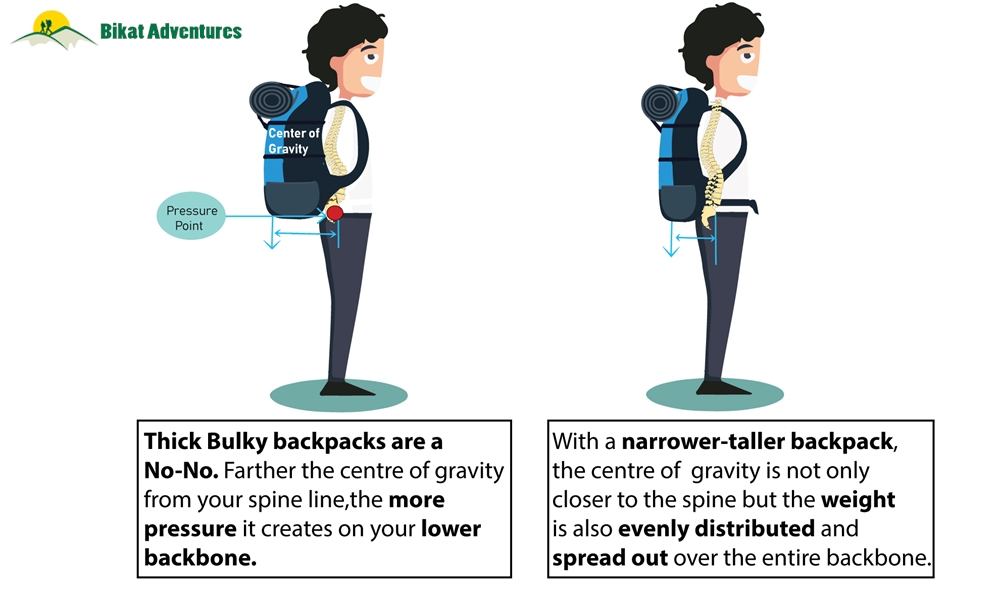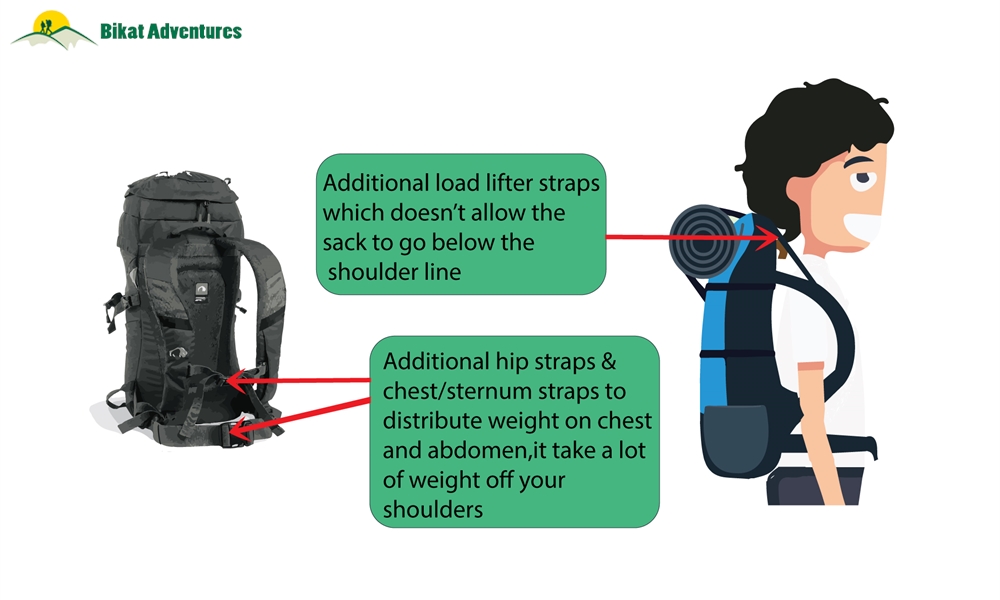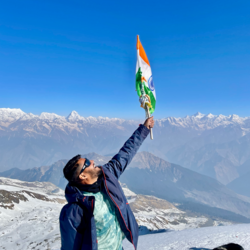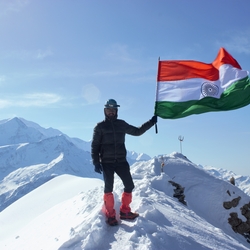Choosing the right backpack isn’t an easy task.
You have expensive, branded packs on one end,
economical, non-branded ones on the other
and so many options in between!

So where does one begin?!
We turned to one of our own for some insights.
He owns a backpack that is non-branded.
He purchased it for ₹ 1100 in 2010.
As per our last count, he has done 15 treks with it.
And what’s more?
The pack continues to work just fine for him!
Meet Pankaj, one of our founders.

Needless to say, we had many questions for him.
Read ahead to know more about the features he looked into while buying his backpack.
Disclaimer:
Since it is a factual article, the information packed in it can sometimes get overwhelming.
We have tried and made it easy to absorb using a generous side of visual representations along with the text.
That said, let’s start with the obvious question :)
Do I really need to buy a backpack for a trek?
It depends on your requirements really.
If you trek often, it is best to invest in a quality backpack.
If not, consider renting a backpack before buying one.
There are so many options to rent these days that
it is possible to do an entire trek on rented gear alone!
In case you are looking to rent gear, our rental section can be found here.
Should I go for a branded or non-branded pack?
You can go for either one as long as you know what to look for when choosing a backpack.
As I already told you, I own a non-branded backpack and it works just fine for me.
Another fellow trekker I know did his BMC, AMC and Rescue Mountaineering Courses with a non-branded backpack.
He has used it for over ten years and has faced no issues with it.
So if you know what to look for in a backpack, then I feel the brand shouldn’t matter as much.
Alright, so what is the first thing to look for when purchasing a backpack?
It is important to fix the capacity of the backpack.
This depends on four factors:
1. Duration of your trek
2. Season of your trek: Winter treks require you to carry additional clothing, gear and equipment.
3. Style of your trek: Independent treks require you to carry your own tent, sleeping bag and food rations as opposed to the assisted ones.
4. Purpose of your trek: For instance, a trip undertaken for photography will require a backpack with specialised space for camera equipment..
Please study the table below for further assistance.

Once the capacity is fixed, what is next?
Once the capacity is fixed, you need to study the material.
You want a backpack that can withstand rough use that comes with any trek.
The material of the main body decides how long a backpack will last.
But how do I identify a god material from a bad one?
This is quite easy. Backpacks are usually made with nylon cloth.
Nylon is the go to material because they offer excellent resistance to water, punctures and abrasion.
Needless to say, these are the deciding factors for the durability of a backpack.
Three types of nylon are used while manufacturing a backpack.
Each type has a distinct look and pattern. So it would be hard to go wrong while identifying them.
Let’s take a look at the pictures below.
SLICK AND SHINY TEXTURE
1.This is Pack Cloth Nylon.
2. It used to be the go to material for backpacks before the advent of newer, smarter material.
3. It offers excellent resistance to water, abrasions and punctures.
4. The only downside is a thinner grade doesn’t provide firmness of structure while a thicker grade makes the backpack heavier.

So with time pack cloth nylon was replaced by two other materials listed below.
Rough and Fuzzy Texture
1. This is Condura Nylon.
2. It is the most popular fabric used today. It offers efficient resistance to abrasion and is light in weight as well.
3. It is not as puncture or water resistant as pack nylon.
4. However the difference is only marginal and is more than made up for by the lightness of its material.

Grid Pattern of Heavy Threads
1. This is Rip- Stop Nylon.
2. It is light in weight and readily accepts water proofing.
3. But it is not as resistant to puncture or abrasion as pack nylon cloth.

Each material seems to have its own downsides. Which one would you recommend amongst the three?
As per my research online, Condura seems to be the most favoured both by manufacturers and consumers because of its light weight and efficient resistance to abrasion.
Once you choose a material, do keep in mind that a good backpack is not made with the same grade of fabric all over.
Different grades of the same fabric are used in order to make the backpacks lighter.
210 D* for Main Body
The main body is usually made with widely spaced fabric.
This fabric has less material per square inch which makes the pack lighter.
Wider spacing is also better for stitching since narrow fabric gets weaker when stitched.
*Note: D stands for Denier, a unit of linear mass density of fibres. Higher D means more fabric per unit area.

500 D* for Base and Shoulder Straps
The bottom of the pack and shoulder straps are usually made with narrowly spaced fabric.
This is done because these two spots need better resistance to abrasion.
*Note: D stands for Denier, a unit of linear mass density of fibres. Higher D means more fabric per unit area.

I must interject here.
If nylon materials offer resistance to water in varying degrees, is it okay to assume all backpacks are water resistant/water proof?
That is a good question.
None of the backpacks are completely water proof.
But the good ones are water resistant.
The question is how do we identify the water resistant ones from the others?
With branded backpacks this shouldn’t be an issue because they come with tags attached.
With the non-branded ones, there are two ways to check for water resistance.
1. Blow air through the fabric
This may come across as a primitive method. But it is more than enough to separate apples from oranges.
But then again, there are different coatings available these days that allow air to pass but not water. One such example is Gore-Tex.
Let’s leave this aside for now though.
2. Check the inside of the pack
Waterproof fabrics usually have a milky coating or a rubber like layer or a shrink wrap like texture on the inside.
If the fabric is coloured on the outside, but white and opaque on the inside, that’s a good indication of the pack being water proof.
I didn't know there were so many details to observe in the material of a backpack.
Once the right material is identfied, what should we look into next?
I know right? It is quite hard to look at backpacks the same way again.
Anyway once the material is chosen, we need to ensure the stitches are strong enough to keep the backpack together.
A good pack has 8-10 stitches per inch.
You can easily measure the number of stitches by placing a scale along a section and manually counting the number of stitches in one inch.
If a backpack has less than 6 stitches per inch, then it is not recommended.
Similarly a backpack with more than 10 stitches per inch is not recommended either. This is because going beyond ten decreases the fabric strength of the backpack.
Once you have identified a backpack with the right material and stitches, we need to look at three smaller but key aspects of the pack.
1. Buckles/Connectors:
> Buckles keep the packed items in your backpack together.
> You do not want your backpack to open midway on a trail because of a defunct buckle or a lack of one.
> So take your time to test the strength and functioning of each buckle.
> Most of the good buckles are available in Acetal or Nylon.
2. Zippers:
> Plastic coiled zippers are the best.
> Plastic toothed zippers are also fine.
> But always avoid a metal toothed zipper.
> This is because metal zippers are less flexible and more prone to damage when stretched horizontally.
3. Ergonomics:
> When on the trails it is painful to have to search for material in your own backpack.
> Look for a pack with multiple chambers and pockets with separate access as well.
> You can find a more detailed discussion on different parts of a backpack and their uses in this article here.
To recap, we have looked into material, stitches, buckles, zippers and ergonomics so far.
What is next?
It has been quite an overload, hasn’t it?
But here’s the good news.
We just have one final aspect to look into.
This is a crucial factor.
The backpack should fit you right!
Much like a shoe, a backpack that is not the right fit can sap you of your energy within a couple of hours of beginning the trek.
And before you know it, you will be looking for a mule or a porter to offload your backpack.
What’s more worrying is a backpack that doesn’t fit you right can even leave you prone to injuries!
To identify a backpack of the right fit, please keep the following points in mind:
1. Avoid backpacks that are thick and bulky. Go for ones that are taller and leaner in structure.

2. Avoid packs that dangle below your shoulder line. A backpack fo the right fit remains firmly rigged to your shoulder line.

3. Ensure your backpack comes with back support. This is important.

4. While it is good to go for backpacks that are taller and leaner in structure, ensure that the backpack is not too long in length.

5. Finally, look for a backpack with additional hip and chest/sternum straps.

Ideally a backpack of the right fit will be one with your body.
It remains firm holding all your belongings in place. In case there is too much relative movement within the backpack, avoid purchasing it because this will require more of your energy to carry.
To wrap up:
When you are choosing a backpack, keep the following factors in mind.
> The material: light in weight, resistant to abrasion and puncture.
> The stitches: Ideally 8-10 stitches per inch.
> Presence of Buckles/Connectors
> Plastic Zippers versus metal ones
> Ergonomics of the pack
> Fit of your backpack
We hope you found this article informative. In case you have any further questions, please post them in the comments section below. Our team will get back to you soon.
Designs created by Ayush Magotra







Hi Pankaj,Thanks for the blog on backpack and rucksack. I have a question on how to choose a proper capacity rucksack that will meet our needs in different treks. I might go for a trek that is for 7 days or 10 days but I'm going to use only 1 rucksack with good space, compartments and rain cover.. since I cannot buy multiple which can meet different needs. Can you please share your thoughts on this.Thanks Vibha
Its a great informative article which surely gonna help me in choosing the right backpack for my trekking needs. Thanks team Bikat,